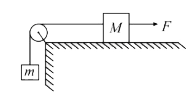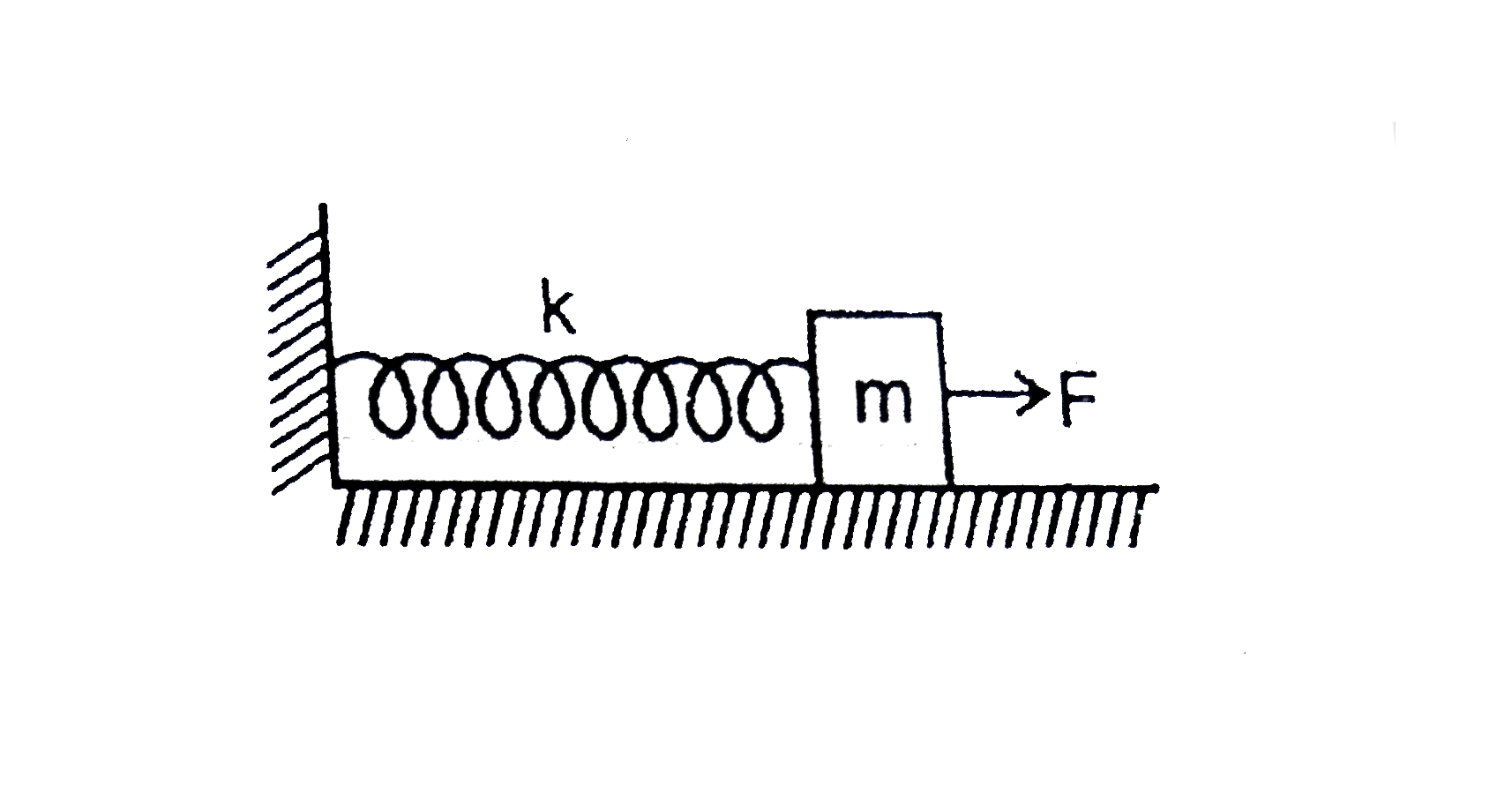A block of mass 'm' is connected to another block of mass 'M' by a spring (massless) of spring constant 'k' The blocks are kept on a smooth horizontal plane. Initially the blocks are at rest and the spring is unstretched Then a constant force 'F' starts acting on the block of mass 'M' to pull it. Find the force on the block of mass 'm' :
mfM
(M+m)Fm
mF(m+M)
MF(m+M)
The correct Answer is:C
To solve the problem, we will analyze the forces acting on both blocks and apply Newton's second law of motion.
1. Identify the System:
We have two blocks:
- Block of mass m (let's call it Block 1)
- Block of mass M (let's call it Block 2)
These blocks are connected by a massless spring of spring constant k and are on a smooth horizontal plane.
2. Understanding the Forces:
A constant force F is applied to Block 2 (mass M). This force will cause both blocks to accelerate. The spring will exert a force (tension T) on Block 1.
3. Applying Newton's Second Law:
- For Block 2 (mass M):
F−T=M⋅a(Equation 1)
- For Block 1 (mass m):
T=m⋅a(Equation 2)
4. Expressing Acceleration:
From Equation 1, we can express the tension T:
T=F−M⋅a
5. Substituting Tension in Equation 2:
Now, substitute the expression for T from Equation 1 into Equation 2:
F−M⋅a=m⋅a
6. Rearranging the Equation:
Rearranging gives:
F=m⋅a+M⋅a
F=(m+M)⋅a
7. Finding Acceleration:
Now, we can solve for acceleration a:
a=Fm+M
8. Finding the Force on Block 1:
Now, substitute a back into Equation 2 to find the force T (the force on Block 1):
T=m⋅a=m⋅Fm+M
T=mFm+M
Final Answer:
The force on the block of mass m is:
T=mFm+M
We have two blocks:
- Block of mass m (let's call it Block 1)
- Block of mass M (let's call it Block 2)
These blocks are connected by a massless spring of spring constant k and are on a smooth horizontal plane.
A constant force F is applied to Block 2 (mass M). This force will cause both blocks to accelerate. The spring will exert a force (tension T) on Block 1.
- For Block 2 (mass M):
F−T=M⋅a(Equation 1)
- For Block 1 (mass m):
T=m⋅a(Equation 2)
From Equation 1, we can express the tension T:
T=F−M⋅a
Now, substitute the expression for T from Equation 1 into Equation 2:
F−M⋅a=m⋅a
Rearranging gives:
F=m⋅a+M⋅a
F=(m+M)⋅a
Now, we can solve for acceleration a:
a=Fm+M
Now, substitute a back into Equation 2 to find the force T (the force on Block 1):
T=m⋅a=m⋅Fm+M
T=mFm+M
The force on the block of mass m is:
T=mFm+M
Topper's Solved these Questions
- DYNAMICS OF A PARTICLEBOOK - VMC MODULES ENGLISHCHAPTER - DYNAMICS OF A PARTICLEEXERCISE - JEE Advance (Archive) Level - II (SINGLE OPTION CORRECT TYPE )
31 Videos
- DYNAMICS OF A PARTICLEBOOK - VMC MODULES ENGLISHCHAPTER - DYNAMICS OF A PARTICLEEXERCISE - LEVEL 2 ( NUMERICAL TYPE FOR JEE MAIN )
16 Videos
- DC CIRCUITBOOK - VMC MODULES ENGLISHCHAPTER - DC CIRCUITEXERCISE - JEE ADVANCED ARCHIVE
68 Videos
- ELECTROMAGNETIC INDUCTION & ALTERNATING CURRENTBOOK - VMC MODULES ENGLISHCHAPTER - ELECTROMAGNETIC INDUCTION & ALTERNATING CURRENTEXERCISE - IN-CHAPTER EXERCISE-G
10 Videos
Similar Questions
A block of mass m is connect to another block of mass M by a massless spring of spring constant k. The blocks are kept on a smooth horizontal plane. Initially the blocks are at rest and the spring is upstretched when a constant force F starts acting on the block of mass M to pull it. Find the maximum extension of the spring.

View SolutionA block of mass m is connect to another block of mass M by a massless spring of spring constant k. The blocks are kept on a smooth horizontal plane. Initially the blocks are at rest and the spring is unsrtretched when a constnt force F starts acting on the block of mass M to pull it. Find the maximum extension of the spring.

View SolutionA block of mass m is connected to another block of mass M by a massless spring of spring constant k. the blocks are kept of a smooth horizontal plane and are at rest. The spring is unstretched when a constant force F starts acting on the block of mass M of pull it. Find the maximum extension of the spring

View SolutionA block of mass m is connected to another block of mass M by a massless spring of spring constant K. Blocks are kept on a smooth horizontal plane. Initally both the blocks the at rest and spring is unstressed. Force F is applied on M to right as shownin the figure then which of the following is correct ?

View SolutionA block of mass m is connected to another .block of mass M by a massless spring of spring constant k. A constant force f starts action as shown in figure, then:

View SolutionA block of mass m suspended from a spring of spring constant k. Find the amplitude of S.H.M.
View SolutionIn the figure shown, all surfaces are smooth and the pulley is massless. A constant force of magnitude F=mg2 is acting on the block of mass M. The acceleration of the block M is :

View SolutionA block of mass m=2kg is connected to a a spring of force constant k=50N/m. Initially the block is at rest and tlhe spring has natural length. A constant force F=60N is applied horizontally towards, the maximum speed of the block (in m/s) will be (negelect friction).

View SolutionA block of mass m is connected to a massless pulley and mass-less spring of stiffness k. The pulley is frictionless. The string is mass-less. Initially the spring is unstretched when the block is released. When the spring is maximum stretched, find the ratio of tenstion in the rope and weight of the block.

View SolutionA block of mass m is connected to a spring of force constant k. Initially the block is at rest and the spring has natural length. A constant force F is applied hrizontally towards right. The maximum speed of the block will be (there is no friction between block and the surface)

View Solution
